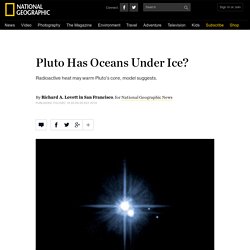

Black Hole Comparison. NASA Ames’ Worden reveals DARPA-funded ‘Hundred Year Starship’ program. Video of Pete Worden and Peter Schwartz.

Audio podcast of the full 19-minute conversation also available. NASA Ames Director Simon “Pete” Worden revealed Saturday that NASA Ames has “just started a project with DARPA called the Hundred Year Starship,” with $1 million funding from DARPA and $100K from NASA. “You heard it here,” said Worden at “Long Conversation,” a Long Now Foundation event in San Francisco. “We also hope to inveigle some billionaires to form a Hundred Year Starship fund,” Dr.
Worden added. “The human space program is now really aimed at settling other worlds,” he explained. To Boldly Go: A One-Way Human Mission to Mars New propulsion ideas Worden also mentioned some nearer-term ideas that NASA is exploring (and that are not necessarily related to the Starship program). At 6.6 Billion Suns, The Largest Black Hole Ever Measured Could Swallow Our Solar System. A universal heavyweight champion was crowned this morning at the 217th meeting of the American Astronomical Society in Seattle: A giant black hole weighing a staggering 6.6 billion suns accepted the title of the most massive black hole for which a precise mass has been determined.

That's not to say it's necessarily the largest black hole in the universe by any means, but in this neck of the cosmic woods we haven't measured a bigger one. Located at the heart of the galaxy M87 some 50 million light years away in the direction of Virgo, the black hole is so big it could swallow our solar system hole easily. Its event horizon--the boundary at which nothing, not even light, can escape the monster's gravitational pull--is four times as large as the orbit of Neptune, our sun's outermost planetary satellite.
Previous estimates of M87's black hole mass registered at some 3 billion suns, still 1,000 times the size of the Milky Way's welterweight black hole. [Science] Huge Black Hole Found in Dwarf Galaxy. A supermassive black hole discovered inside a nearby dwarf galaxy may help explain how galaxies grew in the early universe.

At its center, nearly every large galaxy contains a supermassive black hole surrounded by a big bulge of stars. But whether the black hole or the bulge formed first has long been a chicken-and-egg question in astronomy. (Related: "'Hidden' Black Holes Discovered in Distant Galaxies. ") New x-ray and radio observations of the dwarf galaxy Henize 2-10 show that, while the tiny galaxy lacks a bulge, it very likely contains a supermassive black hole—one about a quarter as large as the black hole at the center of our Milky Way. Henize 2-10 is small and irregularly shaped, and it's actively forming stars, which means it's very similar to early galaxies, researchers say. Hidden in Plain Sight: Researchers Find Galaxy-Scale Bubbles Extending from the Milky Way.
A group of astrophysicists has located two massive bubbles of plasma, each extending tens of thousands of light-years, emitting high-energy radiation above and below the plane of the galaxy. The researchers found the structures in publicly released data from NASA's Fermi Gamma-Ray Space Telescope, which was launched in 2008 to investigate sources of extremely energetic photons—namely, gamma rays, which have higher frequencies than x-rays. Latest From Mars: Frosty Landscapes, Ancient Lakebed, Potential Landing Site. Want to stay on top of all the space news?

Follow @universetoday on Twitter Richardson Crater Dunes, Partially Defrosted. Credit: NASA/JPL/University of Arizona A new batch of images has been released by the HiRISE camera on the Mars Reconnaissaince Orbiter and –as usual — they are stunning. In the image above, there is a lot going on! See more of the “coolest” and latest Mars images from HiRISE below: Megabreccia at Holden Crater.
This image shows what could have been a once-habitable ancient lake on Mars, and a never-before-seen impact “megabreccia” in Holden Crater. A Huge Ocean Likely Covered More Than a Third of Mars 3.5 Billio. It took NASA a few decades, several probes, and a whole lot of money to find hard evidence for the existence of water on the surface of Mars.
But timing is everything. Had the agency been looking for water on the Red Planet a few billion years earlier, all they would've needed was a telescope. A new CU-Boulder analysis of the Martian surface has concluded that a massive ocean covered as much as a third of the planet around 3.5 billion years ago. The CU researchers are by no means the first to suggest that Mars was once home to large oceans, but their research does lend a lot of credence to earlier assertions to that effect, assertions that have been challenged repeatedly over the years. Symphony of Science - 'The Case for Mars' (ft. Zubrin, Sagan, Co. 'Colonizing the Red Planet,' a How-To Guide. Do Seasonal Changes in Mars's Atmosphere Have a Biological Cause?
Methane concentrations on Mars change with the seasons as well as location, and the gas disappears within a Martian year, according to a new study by Italian scientists.

The finding, developed over five Earth years using NASA's Mars Global Surveyor, adds to the ongoing debate about the nature of CH4 on Mars. Methane peaks during the fall in three regions: Tharsis, Elysium and Arabia Terrae. The biggest volcanoes on Mars are in Tharsis and Elysium, and vast amounts of water ice are buried beneath the sands of Arabia Terrae. Methane concentrations drop during winter, and grow so strong in summer that the gas spreads throughout Mars' thin atmosphere, according to Discovery News. Super-Earth Atmosphere May Be Mostly Water. The first direct measurement of a super-Earth exoplanet's atmosphere finds the world is either shrouded in steam or covered in clouds.

Mars Has Liquid Water Close to Surface, Study Hints. Pools of liquid water may even now exist just a few meters below the Martian surface, according to new research.

The finding hints that humans may one day be able to tap into Mars's watery bounty. Although the surface of Mars is too frigid for liquid water to be stable, pockets of water underground could be kept warm enough by an insulating blanket of porous sediment, an international team writes in the November issue of the journal Icarus. (Related: "Liquid Water Recently Seen on Mars? ") Pluto Has Oceans Under Ice? Frigid Pluto, home to some of our solar system's chilliest real estate, may well harbor an ocean beneath its miles-thick ice shell, new research suggests.

Despite its extreme cold, the dwarf planet still appears to be warm enough to "easily" have a subsurface ocean, according to a new model of the rate at which radioactive heat might still warm Pluto's core. And that ocean wouldn't be a mere puddle, noted planetary scientist Guillaume Robuchon of the University of California, Santa Cruz. Rather, the ocean could be 60 to 105 miles (100 to 170 kilometers) thick beneath a 120-mile (200-kilometer) layer of ice, Robuchon said at an annual meeting of the American Geophysical Union in San Francisco earlier this week.
If so, Pluto would join a list of outer solar system bodies—such as Saturn's moons Titan and Enceladus—believed to possibly hold liquid water, a key ingredient for life as we know it. (See "Saturn Moon Has Ice Volcano—And Maybe Life? " Odds of Finding Earth-Size Exoplanets Are 1-in-4. Nearly one in four sun-like stars should host an Earth-mass planet, according to a new census.

The finding is the first quantitative measurement of the frequency of planets of various masses in the galaxy. “It’s a landmark paper,” said exoplanet expert Josh Winn of MIT, who was not involved in the new study. “There’s been all this talk, that low-mass planets like the Earth are very common. Kepler Finds First Definitevely Rocky Exoplanet. SEATTLE — The planet-hunting Kepler Space Telescope has spotted its first rocky exoplanet, astronomers announced today at the meeting of the American Astronomical Society.

“This is the first unquestionably rocky planet orbiting a star outside our solar system,” said astronomer Natalie Batalha of San Jose State University, a member of the Kepler team. “It’s an important milestone for our team, and I think it’s an important milestone for humanity.” The new planet, called Kepler 10-b, orbits a sun-like star 560 light-years away. It was first spotted in July 2009 as it crossed, or transited, in front of its parent star. First Volcano Sighting on Saturn’s Most Earthlike Moon. SAN FRANCISCO — Three icy volcanoes line up on Saturn’s moon Titan, giving some of the best evidence yet that explosive eruptions are possible on worlds beyond Earth.
The volcanic peaks and pits lie in a region called Sotra Facula on Titan’s southern hemisphere. The mountains rise more than 3,000 feet into the air, and the deepest hole sinks nearly 5,000 feet below the surrounding plains, geologists announced in a press conference here at the American Geophysical Union meeting Dec. 14. “It’s a combination of features that you really can’t make any way other than volcanism,” said geophysicist Randolph Kirk of the U.S.
Geological Survey. “That’s what really has excited us: We finally have some proof that Titan is an active world.” Titan is the only body in the solar system other than Earth to have lakes, rivers, clouds, and a cycle of evaporation and mist or rainfall connecting them all. In Flyby of Saturn's Moon Rhea, Cassini Probe Gets First Whiff of Non-Earthly Oxygen. NASA's Cassini spacecraft has taken a breath of oxygen while passing over the icy surface of Saturn's second-largest moon, marking the first time a spacecraft has directly sampled oxygen in the atmosphere of another body. Cruising just 60 miles above Rhea, one of more than 60 moons orbiting Saturn, Cassini found an extremely thin atmosphere of oxygen and carbon dioxide likely sustained by high-energy particles slamming into the moon's frozen surface. Rhea's isn't the only other atmosphere in the universe, but it is so thin that Cassini had to fly through it just to confirm that it was there at all (other atmosphere's have been detected and studied from afar by tools like the Hubble Space Telescope).
According to Cassini's onboard science instruments, Rhea's atmosphere contains something like 50 billion oxygen molecules per cubic meter, matched by 20 billion carbon dioxide molecules. [Guardian] Saturn Moon Has Oxygen Atmosphere. An oxygen atmosphere has been found on Saturn's second largest moon, Rhea, astronomers announced Thursday—but don't hold your breath for colonization opportunities. For one thing, the 932-mile-wide (1,500-kilometer-wide), ice-covered moon is more than 932 million miles (1.5 billion kilometers) from Earth. For another, the average surface temperature is -292 degrees Fahrenheit (-180 degrees Celsius). And at less than 62 miles (100 kilometers) thick, the newfound oxygen layer is so thin that, at Earthlike temperatures and pressure, Rhea's entire atmosphere would fit in a single midsize building. Still, the discovery implies that worlds with oxygen-filled air may not be so unusual in the cosmos.
(Related: "Potentially Habitable Planets Are Common, Study Says. ") At about 327,000 miles (527,000 kilometers) from Saturn, Rhea orbits inside the planet's magnetic field. Knowing where and how oxygen exists in the universe may in turn help scientists plan future robotic and manned missions. Smog on Titan Moon May Hold Ingredients For Life, New Study Says. Scientists studying Titan's atmosphere have learned it can create complex molecules, including amino acids and nucleotide bases, often called the building blocks of life. New Evidence of a Fluid Sea on Saturn’s Moon Titan. "Supernova in a Jar" Offers Peek Inside Star Death.
Previously Unseen Super-Hot Plasma Jets Heat the Sun’s Corona. Space Circles Are Proof of a Pre-Big Bang Universe? Radiation Rings Hint Universe Was Recycled Over and Over. The End of Time is Nigh (in a Cosmic Sense, Anyhow) The universe has only about 3.7 billion years in which to settle its affairs. Video: Spaceport America Inaugurated By Virgin Galactic’s VSS Enterprise. Among the many things about living in the year 2010 that blow my mind (robot vacuums, smartphones, Google Books), the fact that we are at the beginning of commercial space flight is, incredibly, not constantly on my mind.
Yet advances are constantly being made, most visibly by Virgin Galactic, which just this last week inaugurated the commercial facility for vertically- and horizontally-launching aircraft. I mean spacecraft. I’m not sure I’ll ever get used to saying that. Spaceport America, in addition to having a snazzy logo, sports training facilities for Virgin Galactic pilots spacemen, a 10,000ft runway, and will serve as Virgin Galactic’s headquarters for the next two decades. Want to visit? It’s put together by travel blog Gadling, whose crew got to chat up the ever-charming Richard Branson, his eerily similar son (though to be fair, why wouldn’t you want to grow up just like Richard Branson?)
You may wish to postpone your visit until then. The Loneliest Spacecraft in the Universe (soyuz) Dark Jupiter May Haunt Edge of Solar System. Beautiful Universe. Space. Universe's Most Distant Object Spotted. A galaxy 13.12 billion light-years from Earth is the most distant object yet detected, a new study says. 100 epic images from Hubble Space Telescope - Coolvibe. The Asteroids Closest to Killing Us, Visualized. This Is the Oldest Space Object Ever Found.
Farthest Galaxy Cluster Ever Detected. Captured by NASA’s Chandra X-ray Observatory and combined with data from infrared and optical telescopes, this image shows the farthest galaxy cluster ever detected.